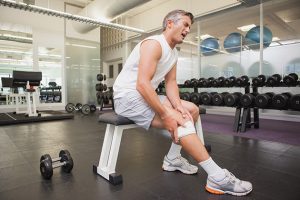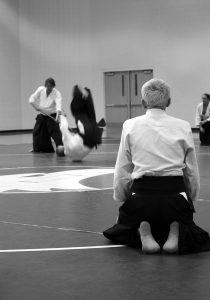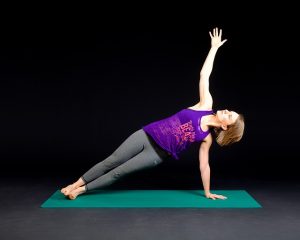New to Fitness in your 40s, 50s, or beyond? Tips for Choosing a Workout Program and Sticking to It

Working out can be fulfilling and fun if you find the right exercises to get the blood flowing. You can burn calories and build strength from a variety of different activities—and making your health and wellness a priority will make you feel better mentally and physically. If you struggle to get motivated, there are ways to add fitness to your life without a big disruption.
First, make exercise a non-negotiable. Let’s say you choose to exercise three times a week. Mark it on your calendar and follow through with it like you would with other essential activities, such as walking the dog, doing laundry, or taking out the garbage. Add it into your weekly routine.
Second, pick the right time in your schedule. Are you more likely to exercise in the morning before work or right when you get home? Can you fit in a quick walk during lunch? How much time can you devote to exercise, and which days of the week work best?
Also, ask for support. Tell your friends and family that you want to make exercise a priority, and let them know how important it is for you to stick to a routine. The more people who back you up, the more likely you are to complete a workout.
Finally, do not worry about setbacks. If you skip a workout, do it the next day or another day of the week. If you can only do 15 minutes, that is okay too. Aim for progress, not perfection.
There are many options when it comes to the types of exercises you can do.
1). Take a walk.
Walking is one of the best activities because it does not cost anything and it is easy to do, provided your joints are up to the task. You can start by walking as little as 10 minutes a day, which adds up to 70 minutes a week. You can walk around your neighborhood or find a local park or trail. You can also watch indoor walking workouts online and do it in your living room, garage, or bedroom. You do not need much space to walk, and it can take as little as 15-20 minutes to walk a mile. Many people start their fitness journeys by walking.
2). Partner up with a friend. Having a workout buddy makes exercise more fun, and it makes you both accountable. You can choose a friend or family member and workout together, or you can keep tabs on each other’s progress, offering encouragement along the way.
3). Join a gym. Sometimes paying money for a service makes you more likely to use it. Some gyms have just weights, while others offer exercise classes, which are good for beginners who are not sure where to start when it comes to a workout program. You may also be able to access a personal trainer and/or nutritionist, who can provide customized exercises and meal plans to meet your goals.
4). Work out at home. You do not have to buy expensive equipment to work out at home. You can get a good burn by simply doing bodyweight exercises, many of which you can do using online videos. You can decide to do just 10 minutes or 60 minutes, depending on how much time you have. The only caveat is that you may be less motivated to exercise at home versus driving to a class for instruction on the way home from work.
5). Try a dance, yoga, or martial arts class. If you ever wanted to learn to ballroom dance or are interested in self-defense, you can do these types of activities and burn some calories. You could also join a golf league, play pickleball, or swim at the YMCA. These are fun, informative classes that are great for motivating you to kick, punch, and tango your way to getting fit.
Working out does not have to be drudgery. Experiment with different programs until you find the right fit, and you will be walking, lifting, or waltzing your way to better health in just a small amount of time.

Want To Live Longer? Take More Time Off
The more time you take off from work, the better off you’ll be (and the longer you’ll live), according to researchers. Why? Vacations are a great way to combat stress.
A 40-year study out of Finland determined that people who took fewer than three weeks of vacation each year were one-third more likely to die young than those who took off more time.
Interestingly, a healthy diet and regular exercise did not equal the benefits of time off as it pertains to relieving stress and living longer, according to the study.
“Don’t think having an otherwise healthy lifestyle will compensate for working too hard and not taking holidays,” said Professor Timo Strandberg of the University of Helsinki. “Vacations can be a good way to relieve stress.”
The study, which was presented at the European Society of Cardiology conference in Munich, commenced in the 1970s and centred on middle-aged men born between 1919 and 1934. All 1,222 participants either smoked, had high blood pressure, or were overweight, increasing their risk of heart disease.
Half of the volunteers were given extra advice to exercise, eat well, maintain a healthy weight and quit smoking. The remaining percentage was not instructed to do the same.
Believe it or not, the first group was actually more likely to die young. Experts believe they may have been subjected to additional stress due to the added advice. Those in the same group who took less than three weeks off each year were 37 per cent more likely to die young over the next three decades.
“The harm caused by the intensive lifestyle regime was concentrated in a subgroup of men with shorter yearly vacation time,” Strandberg noted. “In our study, men with shorter vacations worked more and slept less than those who took longer vacations.
“This stressful lifestyle may have overruled any benefit of the intervention. We think the intervention itself may also have had an adverse psychological effect on these men by adding stress to their lives.”
He added that reducing stress is critical in reducing the risk of cardiovascular disease: “Lifestyle advice should be wisely combined with modern drug treatment to prevent cardiovascular events in high-risk individuals.”
Apple’s Heart Rate App Is Actually Saving Lives
Most people who wear Apple Watches have no idea that they possess life-saving capabilities. The device has been credited with saving a teen and a man over the span of a week.
On April 29, 2018, the watch alerted Deanna Recktenwald, 18, of Tampa Bay, Fla., that her resting heart rate had jumped to 190 beats per minute. She was quickly transported to an emergency room, where she learned she was suffering from kidney failure. Had the watch not intervened, she may have died.
“It was alarming that the watch was telling us to seek medical attention,” Recktenwald’s mother Stacey told ABC Action News. “I didn’t even know that it had the capability of giving us that alert.”
The watch’s heart rate app allows users to see their resting, walking, workout and recovery heart rates throughout the day.
A very grateful Stacey Recktenwald’s contacted Apple to thank the company for developing “such an amazing lifesaving product.” She wrote: “If it wasn’t for her Apple watch alarming her about her HR we wouldn’t have discovered her kidney issue. I honestly feel that your Apple Watch has saved my daughter’s life,”
Apple CEO Tim Cook was moved by the incident and responded on Twitter: “Stories like Deanna’s inspire us to dream bigger and push harder every day.”
Only days after Recktenwald’s made headlines, another person came forward with an Apple Watch life-saving story. William Monzidelis of Westchester, New York, was working at his family’s bowling alley on April 3, 2018, when he didn’t feel well. He noticed bleeding when he went to the bathroom, and his Apple Watch notified him to seek immediate medical attention, reported NBC New York.
His mother took him to the hospital, and en route the 32-year-old lost nearly 80 per cent of his blood. Doctors determined he had an erupted ulcer and required a transfusion.
Doctors believe the watch’s warning encouraged Monzidelis to seek medical help because he likely wouldn’t have paid attention to the warning signs since he was a fairly healthy guy. That delay would have cost him his life.
Monzidelis says skeptics should listen to his story and consider buying their own Apple Watches. “Hopefully my story can push them to use technology,” he said. “In my case, it was like a little angel watching me. It really was a magical device.”
Apple recently partnered with Stanford Medicine to launch the Apple Heart Study app, a study that will use Apple Watch’s heart rate sensor to gather data on irregular heart rhythms and notify users who may be experiencing atrial fibrillation (AFib).
“Every week we receive incredible customer letters about how Apple Watch has affected their lives, including learning that they have AFib,” said Jeff Williams, Apple’s COO.
“These stories inspire us and we’re determined to do more to help people understand their health. Working alongside the medical community, not only can we inform people of certain health conditions, we also hope to advance discoveries in heart science,” Williams added.

Choose Airplane Seats Wisely To Avoid Illness
Frequent fliers take note. If you want to avoid getting sick while travelling, your chances are better off if you nab a window seat, according to a new study. Lead researcher Vicki Stover Hertzberg of Emory University in Atlanta advises, “get in that window seat and don’t move.”
While conducting the study, researchers flew around the world, testing air and cabin surfaces for viruses. They also watched how people came into contact with one another, reported the Boston Globe.
The study was limited. Out of 10 flights, only one traveller was observed coughing. Researchers were also unable to find even one of the 18 cold and flu viruses that they tested for. Hertzberg explained that the researchers were either unlucky or happened to be flying on planes without any sick people onboard.
Chicago-based jet manufacturer Boeing Co. funded the research, which was published in the Proceedings of the National Academy of Sciences. Using mathematical modelling and computer simulations, researchers concluded that a sick passenger sitting in an aisle seat on the 14th row of a single-aisle airplane would infect about one person out of 150 passengers.
The study focused on a topic that is not well researched, but it’s relatively small scope makes it difficult to calculate the exact the risks passengers have for getting sick on a plane.
People who are at the highest risk of getting sick are those who are closest to the passenger with a cold or the flu—those sitting on the infected person’s left and right as well as the people sitting in the rows immediately in front of and behind him or her.
The study found that 38 percent of passengers never left their seats during a flight, while 38 percent left once, 13 percent left twice, and 11 percent left more than once.
Eighty percent of people sitting in aisle seats moved at least one time during their flights compared to 62 percent of passengers in middle seats and 43 percent in window seats.

Group Workouts Are Better Than Solo Ones, Study Says
Is one of your New Year’s resolutions to exercise more? Hitting the local gym may not be the best way to do it. Many people work out by themselves because they prefer creating their own fitness routines and/or they find it difficult to fit group workout sessions into their schedules. Others use personal trainers to hit the sweet spot.
But if you really want to maximize results, you may want to take a fitness class. A new study finds that working out in groups is more beneficial. The report was published in the Journal of the American Osteopathic Association and involved 70 medical students who participated in various exercise routines—in group settings and alone—over the course of three months. Those who exercised with others felt more emotionally and mentally connected.
“Those who participated in group exercise had a 12 to 26 percent improvement in mental, physical and emotional quality of life,” noted Dr. Dayna Yorks of the New England College of Osteopathic Medicine, who also teaches 30-minute exercise classes at the University of Pennsylvania.
Yorks added, “The real power of group exercise is connection. It’s an opportunity for people to connect with each other, connect with their bodies in a positive way.”
Student Darya Nemati told WCAX 3 that she feels really satisfied every time she finishes a fitness class, something that doesn’t happen when she leaves the gym after a solo workout. “I walk out of the class happy every single time. Even if it killed me,” Nemati explained.
Research also shows you’re more likely to stick to a fitness routine if you share it with others.
A recent survey by fitness professionals shows that group classes will be very popular in the coming year. While high intensity interval training (HIIT) is expected to be the top fitness trend, group exercise classes will be the second biggest. Instead of splurging on expensive equipment for the home, people will opt to work out with others.
Amy Dixon, director of group fitness programming for Equinox Fitness Clubs, told NPR that group exercises, such as jumping rope, not only provide professional guidance but also help motivate people, who feel connected to each other.
“In our clubs, those who work out in group classes are the most consistent,” she noted.
People who share a common fitness goal are more likely to continue with their exercise routines. As a result, more and more people are turning to group training versus personal training.
When you’re making your New Year’s resolutions, you may want to add group fitness classes to the list, particularly if you’re afraid you won’t stick to your routine.

Dogs In The Bedroom Are Good For Your Sleep
Some dog owners are so close to their pets that they accompany them everywhere and even sleep with them. New research shows that it’s actually good for one’s health to have a pet sleep near you at night, just as long as you’re not sharing the same bed.
The Mayo Clinic study, called “The Effect of Dogs on Human Sleep in the Home Sleep Environment,” aimed to assess whether people who sleep with their canines in the same bed or bedroom had lower quality of sleep. Fourty dog owners without sleep disorders participated in the study. Their sleep was tracked over the course of five months. During seven nights, both humans and canines wore accelerometers.
Sleep medicine specialist Lois Krahn, M.D. from the Center for Sleep Medicine on Mayo Clinic’s Arizona campus and an author of the study explained, “Most people assume having pets in the bedroom is a disruption. We found that many people actually find comfort and a sense of security from sleeping with their pets.”
What was key, however, is whether the dog was sleeping on the bed or just in the same room as their owner. Individuals who snuggled up to their pets under the covers had a lower quality of sleep compared with those whose pups were relegated to sleeping quarters elsewhere in the room.
The study had its limitations. It included a small sample size, and none of the canines were under six months old. It’s likely that people with fidgety puppies in their bedrooms are less likely to have a good night’s sleep regardless of whether the animal is on the bed or on the floor.
“The relationship between people and their pets has changed over time, which is likely why many people, in fact, do sleep with their pets in the bedroom,” says Dr. Krahn. “Today, many pet owners are away from their pets for much of the day, so they want to maximize their time with them when they are home. Having them in the bedroom at night is an easy way to do that. And, now, pet owners can find comfort knowing it won’t negatively impact their sleep.”
A 2015 study conducted by the Mayo Clinic at the Center for Sleep Medicine followed the sleep habits of 150 participants. More than 50 percent let their pets stay in their bedroom at night, and they claimed the animals disrupted their sleep.

Moderate To Heavy Drinkers More Likely To Reach 85 Without Dementia, Study Finds
Drinking several glasses of wine a day may be good for your health, according to a new study by the University of California San Diego School of Medicine. Older adult men who are moderate to heavy drinkers have a better chance of reaching age 85 without getting dementia or experiencing other cognitive problems.
The study found that when compared to non-drinkers, men and women aged 85 and older who drank “moderate to heavy” amounts of alcohol between five and seven days a week were twice as likely to be cognitively healthy. Moderate drinking is defined as consuming up to two alcoholic beverages a day for adult men under the age of 65 or up to one drink a day for men aged 65 and older. Heavy drinkers are men under 65 who consume four drinks a day or men over age 65 who have up to three alcoholic beverages per day. Anything more than that is considered excessive drinking.
Senior author Linda McEvoy, PhD, an associate professor at UC San Diego School of Medicine, commented: “This study is unique because we considered men and women’s cognitive health at late age and found that alcohol consumption is not only associated with reduced mortality, but with greater chances of remaining cognitively healthy into older age.”
During the 29-year study, researchers examined participants’ cognitive health using a standard dementia screening test. McEvoy pointed out that few people in the study drank excessively, so the results did not show the effects of binge-type drinking. Alcohol-related dementia has been linked to long-term excessive drinkers.
More than 99 percent of the study participants were Caucasian from a middle-to-upper-middle-class area in San Diego County. The majority of those surveyed had some kind of college education and participated from 1984 to 2013.
While the results are promising, it doesn’t mean everyone should start drinking more alcoholic beverages. Lead author Erin Richard, a graduate student in the Joint San Diego State University/UC San Diego Doctoral Program in Public Health, noted: “This study shows that moderate drinking may be part of a healthy lifestyle to maintain cognitive fitness in aging. However, it is not a recommendation for everyone to drink. Some people have health problems that are made worse by alcohol, and others cannot limit their drinking to only a glass or two per day. For these people, drinking can have negative consequences.”
The results were published in August’s Journal of Alzheimer’s Disease.

7 terrible exercises for people over 40
Even if you’ve been active and a frequent exerciser most of your adult life, your workout should reflect your age as well as your experience. If you’re in yo
ur 40s, you shouldn’t be doing the exact same routines you did in your 20s.
Nagging injuries can prevent you from executing proper form, and your body is more susceptible to problems associated with age. Here is a look at seven exercises people over 40 should avoid.
1. Crunches
Ab-targeted exercises alone won’t shave off belly fat. A well-rounded workout combined with a healthy diet will help you lose weight overall. Even if you do 1,000 crunches a day, you can’t get rid of that spare tire without working your entire body. Ab exercises are good for toning muscles that are already trim and lacking fat.
When you’re middle aged, crunches, situps and other ab exercises can cause spinal problems. In extreme cases, you can sustain a spinal fracture. Crunches can also strain your neck and cause poor posture. Unless you keep your back 100 percent straight when doing crunches, you can injure yourself.
As a substitute, try planks instead.
2. Intense cardio
Women in particular love cardio, but it can be strenuous on a middle-aged person who is not used to extreme exercise. If your body is working too hard under stress, it produces the hormone cortisol, which will actually make you gain weight. That’s the exact opposite of what you want to achieve!
Cardio includes jumping jacks. While they are an excellent full-body exercise, they can also be tough on your ligaments. High knees are also strenuous for the joints, tendons and ligaments. They can hurt the knees and hip flexors.
In moderation, cardio is great for your cardiovascular system. But if you’re over 40 and frequently engage in intense cardio routines, it can be difficult on your muscles. So, skip the 60-minute boot camp class and opt for a shorter, high-intensity workout instead.
3. Squats
Squats are one of the most basic and effective exercises for the legs and glutes. However, older bodies are more susceptible to injury, particularly if weights are involved. If done incorrectly, squats can cause lower back and knee injuries due to muscle strains, tears and pulls.
In addition, squats may add muscle to your hips, making them appear wider. Many people will mistake the added bulk for fat gain when it’s actually muscle gain. It’s one area that people usually want to slim down, not emphasize. And because your body’s metabolism slows down after age 40, this is one spot you probably want to keep trim.
Good alternatives to squats are lunges and step-ups.
4. Leg extensions
Leg extensions can be taxing on your knees, particularly as you age. And if heavy weights are involved, it can cause big problems.
Your knees are not built to fully extend while pushing out a heavy set of weights. Knee and ankle injuries are a common problem associated with the use of a leg extension machine. Even younger people should avoid the equipment because it could cause knee problems in the future.
Try dumbbell lunges instead.
5. Deadlifts
If done improperly, deadlifts can be damaging to your back. At the very least, you’ll complain of lower back pain for a few days. At worst, you can suffer a spinal injury. In addition, if you drop the weights while doing a deadlift, you can severely injure your foot.
When you age, it becomes more difficult to maintain proper form because you may have other injuries and try to compensate for the problem. Bent-over rows are a good substitute for deadlifts as long as you use proper form.
6. Triceps dips
One area that people often target is their triceps. Nobody likes their arms to jiggle. However, if you don’t position your arms properly when doing this floor exercise, it can be painful and cause injury. Your upper arms and rotator cuffs include tiny muscles that can be easily damaged.
As an alternative, try triceps pushups or single-arm triceps kickbacks.
7. Behind the neck lat pulldowns
This is a slightly awkward exercise when just using a little amount of weight, so when you start piling on the pounds it puts increasing pressure on your shoulders and rotator cuffs. Some people who perform this exercise sustain shoulder strains and tears.
Close-grip pulldowns in front of the body are a good substitute.
 Cut your chances of cancer and heart disease by biking to work
Cut your chances of cancer and heart disease by biking to work
The League of American Bicyclists notes that 40 percent of all trips in the United States are less than two miles, and cycling is a fun and easy way to run errands and go to the office. Bicycle commuting in the United States is on the rise. In bicycle-friendly communities, commuting rates increased 105 percent from 2000 to 2013, much larger than the national average of 62 percent.
Bike to Work Day is May 19, and a new study shows why you should opt for two wheels instead of four when commuting around town. Research by the University of Glasgow published in the British Medical Journal (BMJ) reveals that cycle commuting is associated with a much lower risk of cardiovascular disease (CVD), cancer and any cause of death.
In general, individuals worldwide are exercising less, in part because fewer people are walking and cycling to work.
The five-year study examined more than 250,000 U.K.-based commuters, with the average age of 52, and found that those who ride their bikes to work have a 45 percent lower chance of developing cancer and a 46 percent lower chance of getting heart disease. During the study, 37 people died; however, 63 would have died had they opted to use a car or public transportation to commute, according to researchers.
Walking to work also has its benefits, but they’re not as big as cycling. Walkers have a 27 percent lower risk of developing CVD and a 36 percent lower risk of dying from the disease. But there was no correlation between walking to work and a decrease in cancer risk.
One of the study’s authors, Dr. Carlos Celis-Morales from the University of Glasgow, told the Telegraph: “This may be because walkers commuted shorter distances than cyclists, typically six miles per week, compared with 30 miles per week, and walking is generally a lower intensity of exercise than cycling.”
According to the World Health Organization, 30 to 50 percent of cancers could be prevented by several factors, which includes regular exercise such as cycling. In 2015, 8.8 million people died of cancer.
Why cycling is so beneficial
There are many reasons why cycling is so good for your health. According to Harvard Medical School, it’s easy on your joints because you put your weight on the bones in the pelvis instead of on your legs. Bicycling is also an aerobic exercise, which benefits the heart, brain and blood vessels.
Cycling is also great for muscles. Pedaling works the buttocks, thighs, hamstrings and calves as well as the flexor muscles in the hips. In addition, the abdomen works to keep you balanced and stay upright while the arms and shoulders help steer.
People who use bicycles are better equipped for walking, standing and stair climbing, and they have better balance and endurance. The act of pushing pedals also increases bone density.
Tips for safe cycling
For those interested in bicycle commuting, several factors should be taken into account. First, be careful if you have heart disease, arthritis, thinning bones or a recent fracture. Talk to a doctor before getting on two wheels.
Also, make sure your bicycle is in good working condition and that the seat is the correct height so you don’t fall off. Wear a helmet, try to use bike paths instead of the street when possible, and carry plenty of water to stay hydrated.
The League of American Bicyclists established Bike to Work Day in 1956, and communities across the United States organize big events to coincide with the May 19 event. In Washington, D.C., Maryland and Virginia alone, more than 85 pit stop events will be held throughout the day. Free commuter convoys will also be scheduled for those who want to bike to work with others.
 The Benefits Of Martial Arts Training For All Ages
The Benefits Of Martial Arts Training For All Ages
Many believe the martial arts are only for the very young and very fit — but, as research shows, that’s simply not true.
With the proliferation of mixed martial arts (MMA) featuring super-toned competitors as well as the abundance of “Little Dragon” karate programs for small children, many traditional schools have seen a drop in adult attendance. People think they’re too old or too out of shape to perform many of the exercises in a typical karate program.
However, for those seeking a good workout, karate offers some excellent fitness benefits for mature practitioners, including improvements in balance, flexibility, endurance and mental health.
A 2015 study in the Journal of Sport and Health Science examined 89 men and woman (average age 70) and determined that after five months of martial arts training, participants experienced “significant improvement in motor reactivity, stress tolerance and divided attention,” including improved memory. And the combination of aerobic, balance and coordination exercises helped boost cognitive functions.
A secondary study proved further cognitive improvements after 10 months of training. If 70-year-olds are experiencing such major improvements by training in the martial arts, imagine what a 45-year-old can achieve in one year of study.
Not only are Tai Chi Chuan, Tae Kwon Do, Kung Fu and other martial arts training good for the brain, but they are also good for the body.
Balance is a key component. As people age, their strength, vision and sensory perception decrease, making balancing more difficult. Without good balance, people are more susceptible to falling and injuring themselves. Martial artists incorporate balance in the stances, kicks and other techniques they execute.
Learning how to fall properly is important for students of all ages, and several styles instruct practitioners in the mechanics of minimizing injury when landing on the ground. A 2010 study in the journal BMC Research Notes found that elderly people can benefit from martial arts training by learning the correct way to fall to reduce hip fractures, which are associated with high mortality and morbidity rates.
“Since martial arts techniques reduce hip impact forces and can be learned by older persons, martial arts fall training may prevent hip fractures among persons with osteoporosis,” Lead author Brenda Groen explained. “We believe that fall training would be safe for persons with osteoporosis if they wear hip protectors during the training, perform fall exercises on a thick mattress, and avoid forward fall exercises from a standing position.”
Stretching is also important in martial arts training. While older adults may not be able to do splits, stretching is necessary to keep muscles flexible and strong. If one doesn’t stretch regularly, muscles shorten and tighten and won’t fully extend when needed, sometimes causing injury. The more flexible a person is, the easier it is for him or her to perform routine and repetitive tasks without harming areas such as the back, hamstrings and shoulders.
Martial arts practice also incorporates endurance training through aerobic exercise. This helps improve cardiovascular, respiratory and muscular health — crucial elements for people of all ages. Kicking targets, sparring with an opponent and performing basic line drills are just some of the ways students can elevate their heart rate.
In addition to physical betterment, many styles of martial arts focus on improving the mind, body and spirit. The “Do” in arts such as Tang Soo Do and Tae Kwon Do translates to “The Way.” This philosophy guides practitioners by improving their mental well-being through both their training and everyday activities.
The key to joining a martial arts program as a mature adult is to rely on modification and to pick a style that suits one’s abilities. If an individual has a bad knee or hip, for example, he or she would want to choose an art that focuses less on kicks. One popular style for older students is Tai Chi Chuan, which emphasizes soft, slow and gentle movements.
After choosing a style to study, practitioners should focus less on keeping up with younger students’ fitness levels and more on improving their own skills on a class-to-class basis.
 Just 30 Minutes Of Exposure To Nature Reduces Depression, Lowers Blood Pressure
Just 30 Minutes Of Exposure To Nature Reduces Depression, Lowers Blood Pressure
People who spend time in green spaces have lower rates of both depression and high blood pressure, according to researchers from the University of Queensland and the ARC Centre of Excellence for Environmental Decisions. In addition, people who frequently commune with nature have greater social cohesion.
If city dwellers spent at least 30 minutes a week in a park, there would be 7 percent fewer cases of depression and 9 percent fewer cases of high blood pressure, the study finds.
UQ CEED researcher Associate Professor Richard Fuller explained (via TreeHugger): “We’ve known for a long time that visiting parks is good for our health, but we are now beginning to establish exactly how much time we need to spend in parks to gain these benefits. We have specific evidence that we need regular visits of at least half an hour to ensure we get these benefits.”
This isn’t the first study with similar conclusions. In fact, simply looking at photos of nature makes people happier. Magdalena van den Berg of VU University Medical Center in Amsterdam recently determined that “short durations of viewing green pictures may help people to recover from stress.”
The National Park Service is celebrating its centennial this year (officially turning 100 on Aug. 25), so if you want to fend off depression and high blood pressure, start planning your trip!
 Scientists Are Packing More Nutrients Into Broccoli To Make It Even Healthier
Scientists Are Packing More Nutrients Into Broccoli To Make It Even Healthier
Broccoli, a superfood, is one of the healthiest veggies you can eat. And now scientists are making it even more nutritious. Researchers are adding more phenolic content to broccoli, which will help lower the risk of certain cancers and coronary heart disease, reports Business Insider.
Eating broccoli is already associated with a lower risk of obesity, diabetes, heart disease and overall mortality, according to Medical News Today. In addition to promoting a healthy complexion and hair, it is also credited with lowering the risk of lung, breast and colon cancer.
Broccolis is also a great source dietary fiber, and contains vitamins A, B1, E, and potassium, calcium and iron.
Geneticist Jack Juvik from the University of Illinois and his team are cross-fertilizing different strains of broccoli to determine which combination would result in the highest concentration of phenolics.
He explained, “These [phenolic compounds] are things we can’t make ourselves, so we have to get them from our diets. These compounds don’t stick around forever, so we need to eat broccoli or some other Brassica vegetable every three or four days to lower the risk of cancers and other degenerative diseases.”
But don’t worry. Broccoli will still taste and look the same after scientists inject more nutrients into it.
The scientists also hope to boost the nutritional value of other vegetables such as kale and cabbage.
 Coffee & Wine Are Good For Your Gut, Study Finds
Coffee & Wine Are Good For Your Gut, Study Finds
Here’s yet another reason to indulge in that cup of morning joe or glass of red wine: they are good for your gut.
A new study focusing on gut bacteria reveals that coffee and wine are bacteria-friendly foods, while soda and simple carbs are not.
Researchers at the University of Groningen in the Netherlands determined that fruit, vegetables, coffee, wine, tea, buttermilk and yogurt help make a person’s gut more diverse, which boosts people’s immunity.
Senior author Dr. Jingyuan Fu explained that foods that are rich in simple carbohydrates reduce bacterial diversity. This includes liquids such as soda and high-fat whole milk. Certain medications are also bad for the gut, including antibiotics and antacids.
Fu’s team examined gut bacteria by taking stool samples from 1,100 people from northern Netherlands. The study, Population-based metagenomics analysis reveals markers for gut microbiome composition and diversity, was published in Science.
 10 Exercise Myths Debunked
10 Exercise Myths Debunked
Most people think working out is a good idea, but not everyone exercises correctly. Some people still believe it’s good to static stretch before warming up or focus on just one part of their bodies to reduce fat. Make sure you know the facts about fitness in order to efficiently and effectively burn those calories.
Check out 10 myths you shouldn’t believe:
1. Women shouldn’t lift weights because they will look bulky.
Strength training is crucial for women who want to lose weight. Weight lifting actually helps you burn fat and lose belly flab. Believe it or not, weight training will help you drop a size because the weight comes from muscle, not fat. Holly Perkins, a certified strength and conditioning specialist, told Fitness magazine: “In fact, body weight often goes up with strength training, but dress size goes down one or two sizes.” Plus, it would take a massive amount of weight lifting for the average woman to look like a body builder.
2. The machine at the gym accurately counts the number of calories burned.
Don’t believe everything you read. According to Jay Cardiello, SHAPE fitness editor and founder of the JCORE Accelerated Body Transformation System, the elliptical is the least accurate when it comes to calorie counting. In fact, most machines overestimate the number of calories burned by a whopping by 42 percent! To combat this issue, try monitoring your heart. Also, you’ll know you’re at maximum intensity if you have trouble trying to sing the lyrics to your favorite song.
3. Walking isn’t an effective form of exercise.
The simple act of walking has several benefits, including strengthening your bones and muscles, improving balance and coordination, maintaining a healthy weight, and promoting a good mood. A brisk 30-minute walk burns 200 calories, according to the Arthritis Foundation. Other benefits? Improved circulation, weight loss, improved sleep, and a drop in mental decline.
4. No pain, no gain.
Some people still believe that if they don’t feel sore after exercising, they didn’t work out hard enough. Feeling a little discomfort is okay, but if you experience long-lasting pain or soreness several days after completing a work out, you are setting yourself up for injury. You also shouldn’t try to work through pain during exercise. Rather than gauge your workout by how much pain you feel, keep track of the amount of weight you lift and the number of repetitions you complete.
5. You can focus on one part of the body, such as your arms, to reduce fat in that one spot.
You lose weight by focusing on your entire body. “Spot reduction” simply doesn’t work. When you exercise, you’re burning fat and breaking down triglycerides throughout your entire body. Targeting a certain area is not the solution — focus instead on an overal slim down.
6. You have to exercise for hours to improve fitness and lose weight.
Researchers published a study in the American Journal of Physiology concluding that 30 minutes of daily exercise results in the same amount of weight loss as 60-minute work outs. Fitness Guru Jillian Michael recommends: “A 30 to 45 minute workout, five times a week, is the ideal way to manage your weight. If you want to lose weight at a faster rate, add more cardio to your routine, but never exceed two hours in a single workout session.”
7. As long as you work out regularly, you can eat what you want.
Mary Jane Detroyer, RD, an exercise physiologist in New York City, told Fitness magazine: “Too often, people overcompensate for exercise. That’s one of the main reasons women don’t get the weight-loss results they anticipate.” You need to be aware of the number of calories in the food you eat as well as the number of calories you burn when you exercise. According to FitDay: “If you eat whatever you please every day, your workout routine won’t be able to catch up to the amount of calories you’re eating. You can still gain weight while working out regularly if you overeat instead of occasionally indulge.”
8. Sit-ups will give you a flat stomach.
Even if you do 100 crunches a day, you won’t get rid of belly flab (see myth #5). The only way to achieve a flatter tummy is to lose weight overall. High-intensity, full-body exercises will help you achieve your goal much better than sit-ups. “Any exercise that gets multiple muscle groups involved is high intensity, and it will increase your body temperature and get your fat burning,” says Yuri Elkaim, BPHE, CK, RHN, a registered holistic nutritionist, fitness expert and health coach. His workout of choice? Running hills, stairs, or circuit training.
9. It’s dangerous to exercise when you’re older.
There are lots of exercise plans for elderly people, who are encouraged to keep moving regardless of their age. The Centers for Disease Control and Prevention suggests 150 minutes of moderate exercise each week for people aged 65 and older. They can increase strength, flexibility and balance through activities such as walking, swimming, and cycling.
10. You should static stretch before working out.
This is also a myth. Studies show that static stretching “as the sole activity during warm-up routine should generally be avoided.” Holding a stretching position doesn’t prevent injuries and may actually impair strength and speed. A study in the Journal of Strength and Conditioning Research determined that pre-workout stretching may actually make you feel weaker.
